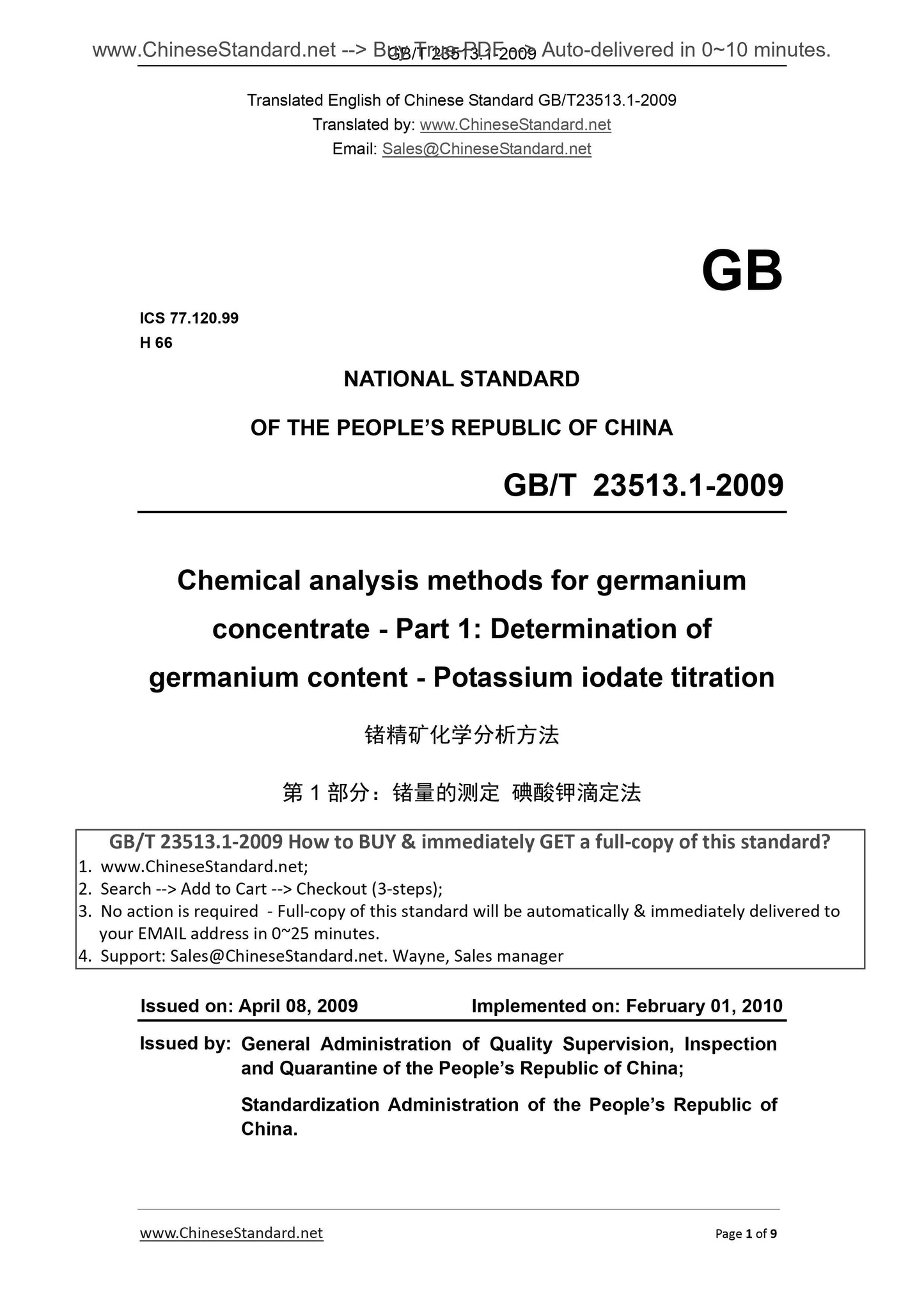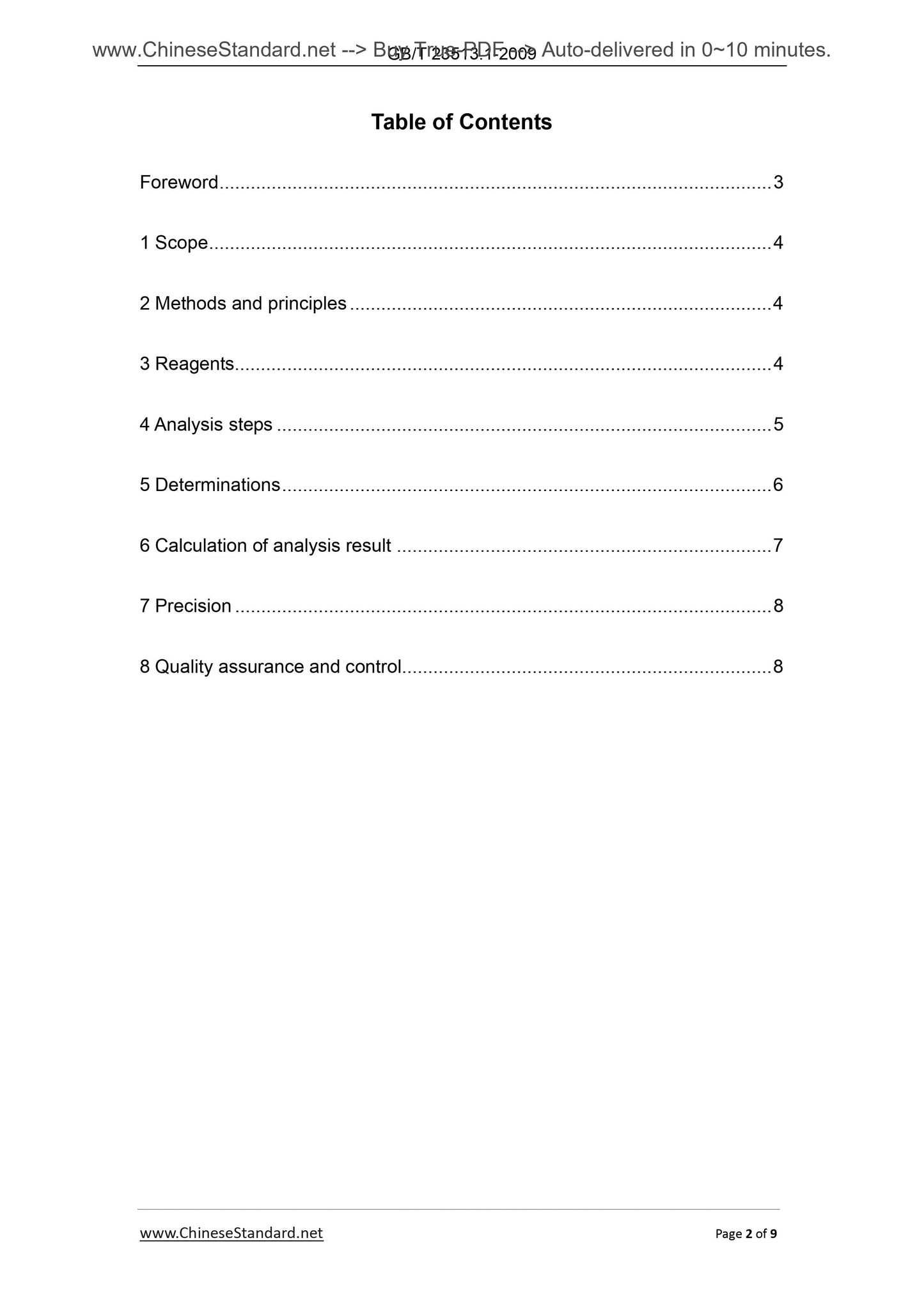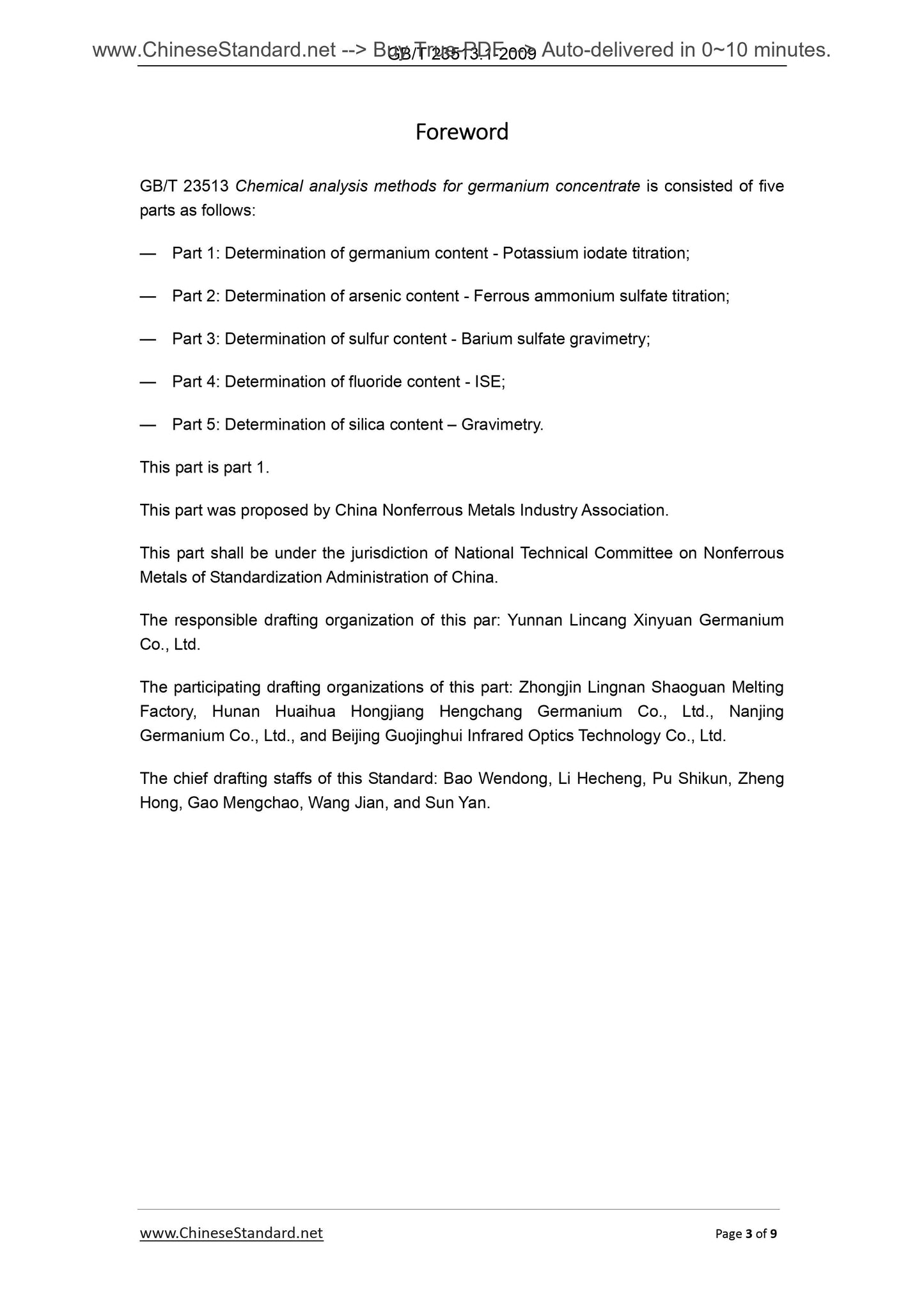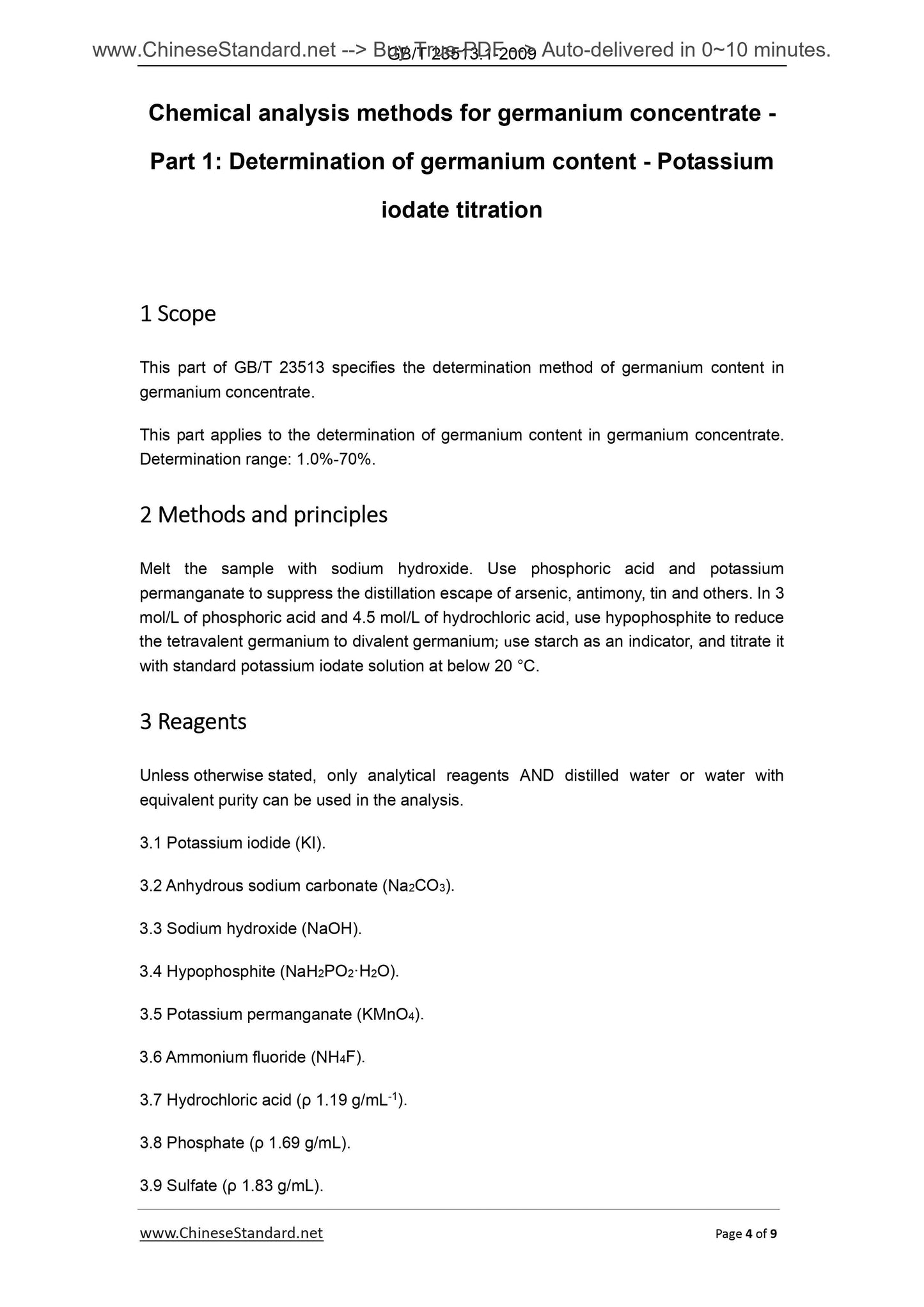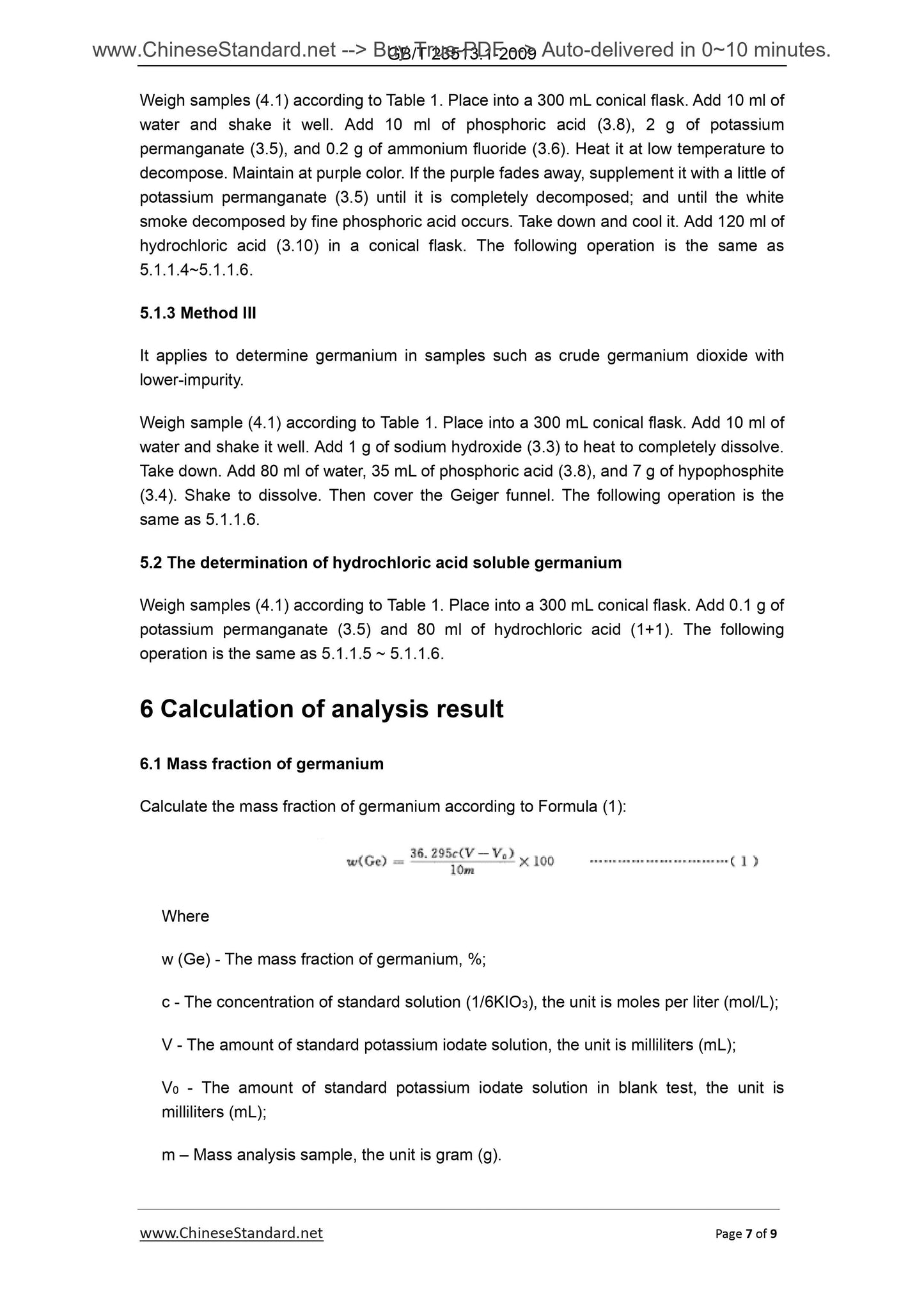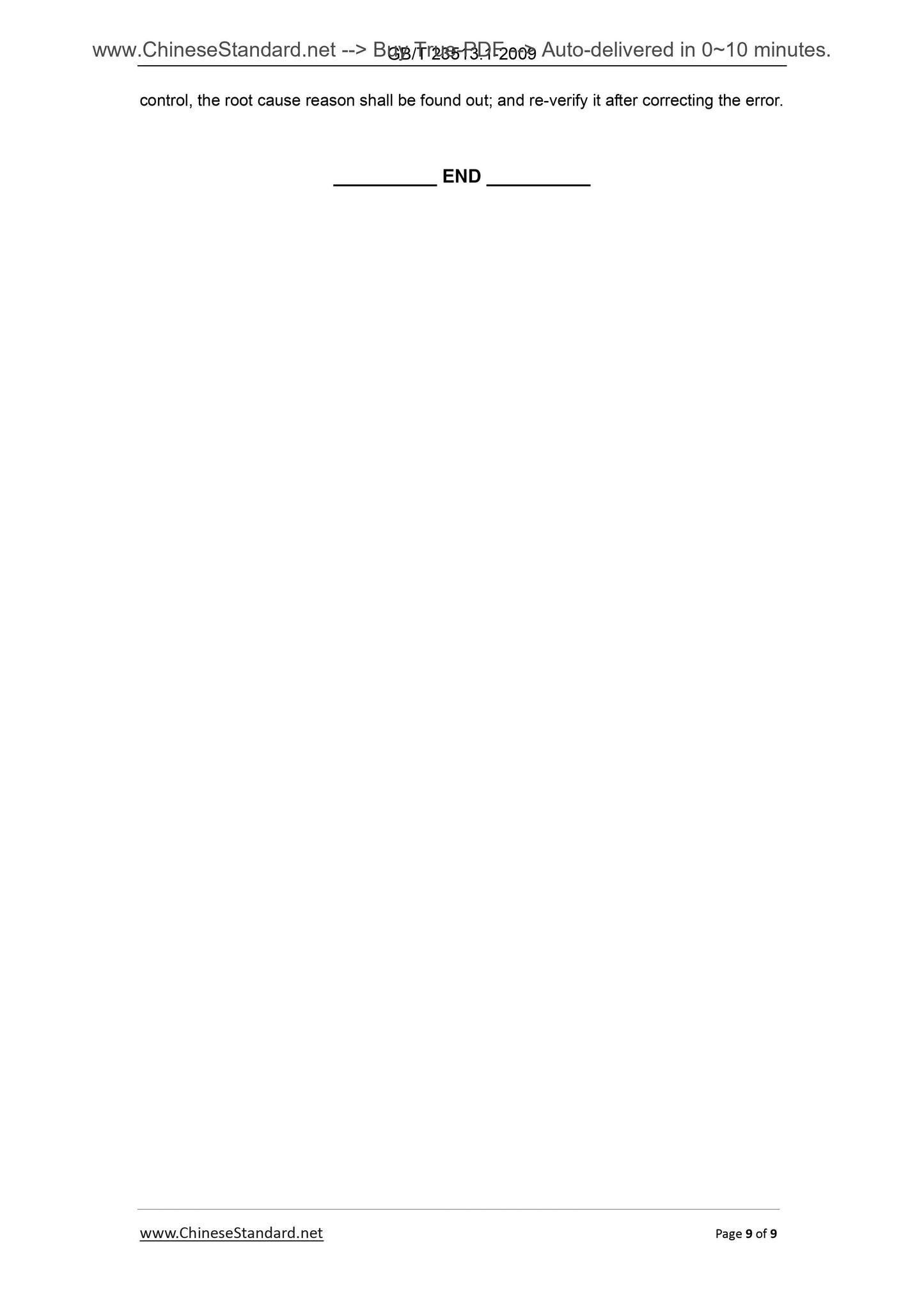1
/
of
6
www.ChineseStandard.us -- Field Test Asia Pte. Ltd.
GB/T 23513.1-2009 English PDF (GB/T23513.1-2009)
GB/T 23513.1-2009 English PDF (GB/T23513.1-2009)
Regular price
$90.00
Regular price
Sale price
$90.00
Unit price
/
per
Shipping calculated at checkout.
Couldn't load pickup availability
GB/T 23513.1-2009: Chemical analysis methods for germanium concentrate -- Part 1: Determination of germanium content -- Potassium iodate titration
Delivery: 9 seconds. Download (& Email) true-PDF + Invoice.
Get Quotation: Click GB/T 23513.1-2009 (Self-service in 1-minute)
Historical versions (Master-website): GB/T 23513.1-2009
Preview True-PDF (Reload/Scroll-down if blank)
GB/T 23513.1-2009
GB/T23513.1-2009
GB
ICS 77.120.99
H 66
NATIONAL STANDARD
OF THE PEOPLE’S REPUBLIC OF CHINA
Chemical analysis methods for germanium
concentrate - Part 1. Determination of
germanium content - Potassium iodate titration
ISSUED ON. APRIL 08, 2009
IMPLEMENTED ON. FEBRUARY 01, 2010
Issued by.
General Administration of Quality Supervision, Inspection
and Quarantine of the People’s Republic of China;
Standardization Administration of the People’s Republic of
China.
Table of Contents
Foreword ... 3
1 Scope ... 4
2 Methods and principles ... 4
3 Reagents... 4
4 Analysis steps ... 5
5 Determinations ... 6
6 Calculation of analysis result ... 7
7 Precision ... 8
8 Quality assurance and control... 8
Foreword
GB/T 23513 Chemical analysis methods for germanium concentrate is consisted of five
parts as follows.
— Part 1. Determination of germanium content - Potassium iodate titration;
— Part 2. Determination of arsenic content - Ferrous ammonium sulfate titration;
— Part 3. Determination of sulfur content - Barium sulfate gravimetry;
— Part 4. Determination of fluoride content - ISE;
— Part 5. Determination of silica content – Gravimetry.
This part is part 1.
This part was proposed by China Nonferrous Metals Industry Association.
This part shall be under the jurisdiction of National Technical Committee on Nonferrous
Metals of Standardization Administration of China.
The responsible drafting organization of this par. Yunnan Lincang Xinyuan Germanium
Co., Ltd.
The participating drafting organizations of this part. Zhongjin Lingnan Shaoguan Melting
Factory, Hunan Huaihua Hongjiang Hengchang Germanium Co., Ltd., Nanjing
Germanium Co., Ltd., and Beijing Guojinghui Infrared Optics Technology Co., Ltd.
The chief drafting staffs of this Standard. Bao Wendong, Li Hecheng, Pu Shikun, Zheng
Hong, Gao Mengchao, Wang Jian, and Sun Yan.
Chemical analysis methods for germanium concentrate -
Part 1. Determination of germanium content - Potassium
iodate titration
1 Scope
This part of GB/T 23513 specifies the determination method of germanium content in
germanium concentrate.
This part applies to the determination of germanium content in germanium concentrate.
Determination range. 1.0%-70%.
2 Methods and principles
Melt the sample with sodium hydroxide. Use phosphoric acid and potassium
permanganate to suppress the distillation escape of arsenic, antimony, tin and others. In 3
mol/L of phosphoric acid and 4.5 mol/L of hydrochloric acid, use hypophosphite to reduce
the tetravalent germanium to divalent germanium; use starch as an indicator, and titrate it
with standard potassium iodate solution at below 20 °C.
3 Reagents
Unless otherwise stated, only analytical reagents AND distilled water or water with
equivalent purity can be used in the analysis.
3.1 Potassium iodide (KI).
3.2 Anhydrous sodium carbonate (Na2CO3).
3.3 Sodium hydroxide (NaOH).
3.4 Hypophosphite (NaH2PO2·H2O).
3.5 Potassium permanganate (KMnO4).
3.6 Ammonium fluoride (NH4F).
3.7 Hydrochloric acid (ρ 1.19 g/mL-1).
3.8 Phosphate (ρ 1.69 g/mL).
3.9 Sulfate (ρ 1.83 g/mL).
Weigh samples (4.1) according to Table 1. Place into a 300 mL conical flask. Add 10 ml of
water and shake it well. Add 10 ml of phosphoric acid (3.8), 2 g of potassium
permanganate (3.5), and 0.2 g of ammonium fluoride (3.6). Heat it at low temperature to
decompose. Maintain at purple color. If the purple fades away, supplement it with a little of
potassium permanganate (3.5) until it is completely decomposed; and until the white
smoke decomposed by fine phosphoric acid occurs. Take down and cool it. Add 120 ml of
hydrochloric acid (3.10) in a conical flask. The following operation is the same as
5.1.1.4~5.1.1.6.
5.1.3 Method III
It applies to determine germanium in samples such as crude germanium dioxide with
lower-impurity.
Weigh sample (4.1) according to Table 1. Place into a 300 mL conical flask. Add 10 ml of
water and shake it well. Add 1 g of sodium hydroxide (3.3) to heat to completely dissolve.
Take down. Add 80 ml of water, 35 mL of phosphoric acid (3.8), and 7 g of hypophosphite
(3.4). Shake to dissolve. Then cover the Geiger funnel. The following operation is the
same as 5.1.1.6.
5.2 The determination of hydrochloric acid soluble germanium
Weigh samples (4.1) according to Table 1. Place into a 300 mL conical flask. Add 0.1 g of
potassium permanganate (3.5) and 80 ml of hydrochloric acid (1+1). The following
operation is the same as 5.1.1.5 ~ 5.1.1.6.
6 Calculation of analysis result
6.1 Mass fraction of germanium
Calculate the mass fraction of germanium according to Formula (1).
Where
w (Ge) - The mass fraction of germanium, %;
c - The concentration of standard solution (1/6KIO3), the unit is moles per liter (mol/L);
V - The amount of standard potassium iodate solution, the unit is milliliters (mL);
V0 - The amount of standard potassium iodate solution in blank test, the unit is
milliliters (mL);
m – Mass analysis sample, the unit is gram (g).
control, the root cause reason shall be found out; and re-verify it after correcting the error.
GB/T 23513.1-2009
GB/T23513.1-2009
GB
ICS 77.120.99
H 66
NATIONAL STANDARD
OF THE PEOPLE’S REPUBLIC OF CHINA
Chemical analysis methods for germanium
concentrate - Part 1. Determination of
germanium content - Potassium iodate titration
ISSUED ON. APRIL 08, 2009
IMPLEMENTED ON. FEBRUARY 01, 2010
Issued by.
General Administration of Quality Supervision, Inspection
and Quarantine of the People’s Republic of China;
Standardization Administration of the People’s Republic of
China.
Table of Contents
Foreword ... 3
1 Scope ... 4
2 Methods and principles ... 4
3 Reagents... 4
4 Analysis steps ... 5
5 Determinations ... 6
6 Calculation of analysis result ... 7
7 Precision ... 8
8 Quality assurance and control... 8
Foreword
GB/T 23513 Chemical analysis methods for germanium concentrate is consisted of five
parts as follows.
— Part 1. Determination of germanium content - Potassium iodate titration;
— Part 2. Determination of arsenic content - Ferrous ammonium sulfate titration;
— Part 3. Determination of sulfur content - Barium sulfate gravimetry;
— Part 4. Determination of fluoride content - ISE;
— Part 5. Determination of silica content – Gravimetry.
This part is part 1.
This part was proposed by China Nonferrous Metals Industry Association.
This part shall be under the jurisdiction of National Technical Committee on Nonferrous
Metals of Standardization Administration of China.
The responsible drafting organization of this par. Yunnan Lincang Xinyuan Germanium
Co., Ltd.
The participating drafting organizations of this part. Zhongjin Lingnan Shaoguan Melting
Factory, Hunan Huaihua Hongjiang Hengchang Germanium Co., Ltd., Nanjing
Germanium Co., Ltd., and Beijing Guojinghui Infrared Optics Technology Co., Ltd.
The chief drafting staffs of this Standard. Bao Wendong, Li Hecheng, Pu Shikun, Zheng
Hong, Gao Mengchao, Wang Jian, and Sun Yan.
Chemical analysis methods for germanium concentrate -
Part 1. Determination of germanium content - Potassium
iodate titration
1 Scope
This part of GB/T 23513 specifies the determination method of germanium content in
germanium concentrate.
This part applies to the determination of germanium content in germanium concentrate.
Determination range. 1.0%-70%.
2 Methods and principles
Melt the sample with sodium hydroxide. Use phosphoric acid and potassium
permanganate to suppress the distillation escape of arsenic, antimony, tin and others. In 3
mol/L of phosphoric acid and 4.5 mol/L of hydrochloric acid, use hypophosphite to reduce
the tetravalent germanium to divalent germanium; use starch as an indicator, and titrate it
with standard potassium iodate solution at below 20 °C.
3 Reagents
Unless otherwise stated, only analytical reagents AND distilled water or water with
equivalent purity can be used in the analysis.
3.1 Potassium iodide (KI).
3.2 Anhydrous sodium carbonate (Na2CO3).
3.3 Sodium hydroxide (NaOH).
3.4 Hypophosphite (NaH2PO2·H2O).
3.5 Potassium permanganate (KMnO4).
3.6 Ammonium fluoride (NH4F).
3.7 Hydrochloric acid (ρ 1.19 g/mL-1).
3.8 Phosphate (ρ 1.69 g/mL).
3.9 Sulfate (ρ 1.83 g/mL).
Weigh samples (4.1) according to Table 1. Place into a 300 mL conical flask. Add 10 ml of
water and shake it well. Add 10 ml of phosphoric acid (3.8), 2 g of potassium
permanganate (3.5), and 0.2 g of ammonium fluoride (3.6). Heat it at low temperature to
decompose. Maintain at purple color. If the purple fades away, supplement it with a little of
potassium permanganate (3.5) until it is completely decomposed; and until the white
smoke decomposed by fine phosphoric acid occurs. Take down and cool it. Add 120 ml of
hydrochloric acid (3.10) in a conical flask. The following operation is the same as
5.1.1.4~5.1.1.6.
5.1.3 Method III
It applies to determine germanium in samples such as crude germanium dioxide with
lower-impurity.
Weigh sample (4.1) according to Table 1. Place into a 300 mL conical flask. Add 10 ml of
water and shake it well. Add 1 g of sodium hydroxide (3.3) to heat to completely dissolve.
Take down. Add 80 ml of water, 35 mL of phosphoric acid (3.8), and 7 g of hypophosphite
(3.4). Shake to dissolve. Then cover the Geiger funnel. The following operation is the
same as 5.1.1.6.
5.2 The determination of hydrochloric acid soluble germanium
Weigh samples (4.1) according to Table 1. Place into a 300 mL conical flask. Add 0.1 g of
potassium permanganate (3.5) and 80 ml of hydrochloric acid (1+1). The following
operation is the same as 5.1.1.5 ~ 5.1.1.6.
6 Calculation of analysis result
6.1 Mass fraction of germanium
Calculate the mass fraction of germanium according to Formula (1).
Where
w (Ge) - The mass fraction of germanium, %;
c - The concentration of standard solution (1/6KIO3), the unit is moles per liter (mol/L);
V - The amount of standard potassium iodate solution, the unit is milliliters (mL);
V0 - The amount of standard potassium iodate solution in blank test, the unit is
milliliters (mL);
m – Mass analysis sample, the unit is gram (g).
control, the root cause reason shall be found out; and re-verify it after correcting the error.
Delivery: 9 seconds. Download (& Email) true-PDF + Invoice.
Get Quotation: Click GB/T 23513.1-2009 (Self-service in 1-minute)
Historical versions (Master-website): GB/T 23513.1-2009
Preview True-PDF (Reload/Scroll-down if blank)
GB/T 23513.1-2009
GB/T23513.1-2009
GB
ICS 77.120.99
H 66
NATIONAL STANDARD
OF THE PEOPLE’S REPUBLIC OF CHINA
Chemical analysis methods for germanium
concentrate - Part 1. Determination of
germanium content - Potassium iodate titration
ISSUED ON. APRIL 08, 2009
IMPLEMENTED ON. FEBRUARY 01, 2010
Issued by.
General Administration of Quality Supervision, Inspection
and Quarantine of the People’s Republic of China;
Standardization Administration of the People’s Republic of
China.
Table of Contents
Foreword ... 3
1 Scope ... 4
2 Methods and principles ... 4
3 Reagents... 4
4 Analysis steps ... 5
5 Determinations ... 6
6 Calculation of analysis result ... 7
7 Precision ... 8
8 Quality assurance and control... 8
Foreword
GB/T 23513 Chemical analysis methods for germanium concentrate is consisted of five
parts as follows.
— Part 1. Determination of germanium content - Potassium iodate titration;
— Part 2. Determination of arsenic content - Ferrous ammonium sulfate titration;
— Part 3. Determination of sulfur content - Barium sulfate gravimetry;
— Part 4. Determination of fluoride content - ISE;
— Part 5. Determination of silica content – Gravimetry.
This part is part 1.
This part was proposed by China Nonferrous Metals Industry Association.
This part shall be under the jurisdiction of National Technical Committee on Nonferrous
Metals of Standardization Administration of China.
The responsible drafting organization of this par. Yunnan Lincang Xinyuan Germanium
Co., Ltd.
The participating drafting organizations of this part. Zhongjin Lingnan Shaoguan Melting
Factory, Hunan Huaihua Hongjiang Hengchang Germanium Co., Ltd., Nanjing
Germanium Co., Ltd., and Beijing Guojinghui Infrared Optics Technology Co., Ltd.
The chief drafting staffs of this Standard. Bao Wendong, Li Hecheng, Pu Shikun, Zheng
Hong, Gao Mengchao, Wang Jian, and Sun Yan.
Chemical analysis methods for germanium concentrate -
Part 1. Determination of germanium content - Potassium
iodate titration
1 Scope
This part of GB/T 23513 specifies the determination method of germanium content in
germanium concentrate.
This part applies to the determination of germanium content in germanium concentrate.
Determination range. 1.0%-70%.
2 Methods and principles
Melt the sample with sodium hydroxide. Use phosphoric acid and potassium
permanganate to suppress the distillation escape of arsenic, antimony, tin and others. In 3
mol/L of phosphoric acid and 4.5 mol/L of hydrochloric acid, use hypophosphite to reduce
the tetravalent germanium to divalent germanium; use starch as an indicator, and titrate it
with standard potassium iodate solution at below 20 °C.
3 Reagents
Unless otherwise stated, only analytical reagents AND distilled water or water with
equivalent purity can be used in the analysis.
3.1 Potassium iodide (KI).
3.2 Anhydrous sodium carbonate (Na2CO3).
3.3 Sodium hydroxide (NaOH).
3.4 Hypophosphite (NaH2PO2·H2O).
3.5 Potassium permanganate (KMnO4).
3.6 Ammonium fluoride (NH4F).
3.7 Hydrochloric acid (ρ 1.19 g/mL-1).
3.8 Phosphate (ρ 1.69 g/mL).
3.9 Sulfate (ρ 1.83 g/mL).
Weigh samples (4.1) according to Table 1. Place into a 300 mL conical flask. Add 10 ml of
water and shake it well. Add 10 ml of phosphoric acid (3.8), 2 g of potassium
permanganate (3.5), and 0.2 g of ammonium fluoride (3.6). Heat it at low temperature to
decompose. Maintain at purple color. If the purple fades away, supplement it with a little of
potassium permanganate (3.5) until it is completely decomposed; and until the white
smoke decomposed by fine phosphoric acid occurs. Take down and cool it. Add 120 ml of
hydrochloric acid (3.10) in a conical flask. The following operation is the same as
5.1.1.4~5.1.1.6.
5.1.3 Method III
It applies to determine germanium in samples such as crude germanium dioxide with
lower-impurity.
Weigh sample (4.1) according to Table 1. Place into a 300 mL conical flask. Add 10 ml of
water and shake it well. Add 1 g of sodium hydroxide (3.3) to heat to completely dissolve.
Take down. Add 80 ml of water, 35 mL of phosphoric acid (3.8), and 7 g of hypophosphite
(3.4). Shake to dissolve. Then cover the Geiger funnel. The following operation is the
same as 5.1.1.6.
5.2 The determination of hydrochloric acid soluble germanium
Weigh samples (4.1) according to Table 1. Place into a 300 mL conical flask. Add 0.1 g of
potassium permanganate (3.5) and 80 ml of hydrochloric acid (1+1). The following
operation is the same as 5.1.1.5 ~ 5.1.1.6.
6 Calculation of analysis result
6.1 Mass fraction of germanium
Calculate the mass fraction of germanium according to Formula (1).
Where
w (Ge) - The mass fraction of germanium, %;
c - The concentration of standard solution (1/6KIO3), the unit is moles per liter (mol/L);
V - The amount of standard potassium iodate solution, the unit is milliliters (mL);
V0 - The amount of standard potassium iodate solution in blank test, the unit is
milliliters (mL);
m – Mass analysis sample, the unit is gram (g).
control, the root cause reason shall be found out; and re-verify it after correcting the error.
GB/T 23513.1-2009
GB/T23513.1-2009
GB
ICS 77.120.99
H 66
NATIONAL STANDARD
OF THE PEOPLE’S REPUBLIC OF CHINA
Chemical analysis methods for germanium
concentrate - Part 1. Determination of
germanium content - Potassium iodate titration
ISSUED ON. APRIL 08, 2009
IMPLEMENTED ON. FEBRUARY 01, 2010
Issued by.
General Administration of Quality Supervision, Inspection
and Quarantine of the People’s Republic of China;
Standardization Administration of the People’s Republic of
China.
Table of Contents
Foreword ... 3
1 Scope ... 4
2 Methods and principles ... 4
3 Reagents... 4
4 Analysis steps ... 5
5 Determinations ... 6
6 Calculation of analysis result ... 7
7 Precision ... 8
8 Quality assurance and control... 8
Foreword
GB/T 23513 Chemical analysis methods for germanium concentrate is consisted of five
parts as follows.
— Part 1. Determination of germanium content - Potassium iodate titration;
— Part 2. Determination of arsenic content - Ferrous ammonium sulfate titration;
— Part 3. Determination of sulfur content - Barium sulfate gravimetry;
— Part 4. Determination of fluoride content - ISE;
— Part 5. Determination of silica content – Gravimetry.
This part is part 1.
This part was proposed by China Nonferrous Metals Industry Association.
This part shall be under the jurisdiction of National Technical Committee on Nonferrous
Metals of Standardization Administration of China.
The responsible drafting organization of this par. Yunnan Lincang Xinyuan Germanium
Co., Ltd.
The participating drafting organizations of this part. Zhongjin Lingnan Shaoguan Melting
Factory, Hunan Huaihua Hongjiang Hengchang Germanium Co., Ltd., Nanjing
Germanium Co., Ltd., and Beijing Guojinghui Infrared Optics Technology Co., Ltd.
The chief drafting staffs of this Standard. Bao Wendong, Li Hecheng, Pu Shikun, Zheng
Hong, Gao Mengchao, Wang Jian, and Sun Yan.
Chemical analysis methods for germanium concentrate -
Part 1. Determination of germanium content - Potassium
iodate titration
1 Scope
This part of GB/T 23513 specifies the determination method of germanium content in
germanium concentrate.
This part applies to the determination of germanium content in germanium concentrate.
Determination range. 1.0%-70%.
2 Methods and principles
Melt the sample with sodium hydroxide. Use phosphoric acid and potassium
permanganate to suppress the distillation escape of arsenic, antimony, tin and others. In 3
mol/L of phosphoric acid and 4.5 mol/L of hydrochloric acid, use hypophosphite to reduce
the tetravalent germanium to divalent germanium; use starch as an indicator, and titrate it
with standard potassium iodate solution at below 20 °C.
3 Reagents
Unless otherwise stated, only analytical reagents AND distilled water or water with
equivalent purity can be used in the analysis.
3.1 Potassium iodide (KI).
3.2 Anhydrous sodium carbonate (Na2CO3).
3.3 Sodium hydroxide (NaOH).
3.4 Hypophosphite (NaH2PO2·H2O).
3.5 Potassium permanganate (KMnO4).
3.6 Ammonium fluoride (NH4F).
3.7 Hydrochloric acid (ρ 1.19 g/mL-1).
3.8 Phosphate (ρ 1.69 g/mL).
3.9 Sulfate (ρ 1.83 g/mL).
Weigh samples (4.1) according to Table 1. Place into a 300 mL conical flask. Add 10 ml of
water and shake it well. Add 10 ml of phosphoric acid (3.8), 2 g of potassium
permanganate (3.5), and 0.2 g of ammonium fluoride (3.6). Heat it at low temperature to
decompose. Maintain at purple color. If the purple fades away, supplement it with a little of
potassium permanganate (3.5) until it is completely decomposed; and until the white
smoke decomposed by fine phosphoric acid occurs. Take down and cool it. Add 120 ml of
hydrochloric acid (3.10) in a conical flask. The following operation is the same as
5.1.1.4~5.1.1.6.
5.1.3 Method III
It applies to determine germanium in samples such as crude germanium dioxide with
lower-impurity.
Weigh sample (4.1) according to Table 1. Place into a 300 mL conical flask. Add 10 ml of
water and shake it well. Add 1 g of sodium hydroxide (3.3) to heat to completely dissolve.
Take down. Add 80 ml of water, 35 mL of phosphoric acid (3.8), and 7 g of hypophosphite
(3.4). Shake to dissolve. Then cover the Geiger funnel. The following operation is the
same as 5.1.1.6.
5.2 The determination of hydrochloric acid soluble germanium
Weigh samples (4.1) according to Table 1. Place into a 300 mL conical flask. Add 0.1 g of
potassium permanganate (3.5) and 80 ml of hydrochloric acid (1+1). The following
operation is the same as 5.1.1.5 ~ 5.1.1.6.
6 Calculation of analysis result
6.1 Mass fraction of germanium
Calculate the mass fraction of germanium according to Formula (1).
Where
w (Ge) - The mass fraction of germanium, %;
c - The concentration of standard solution (1/6KIO3), the unit is moles per liter (mol/L);
V - The amount of standard potassium iodate solution, the unit is milliliters (mL);
V0 - The amount of standard potassium iodate solution in blank test, the unit is
milliliters (mL);
m – Mass analysis sample, the unit is gram (g).
control, the root cause reason shall be found out; and re-verify it after correcting the error.
Share
